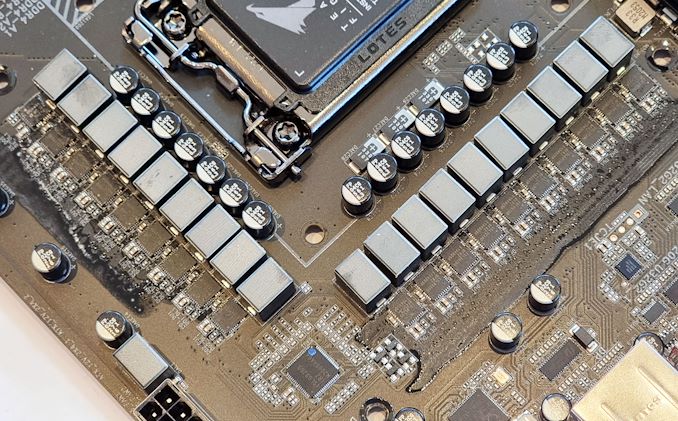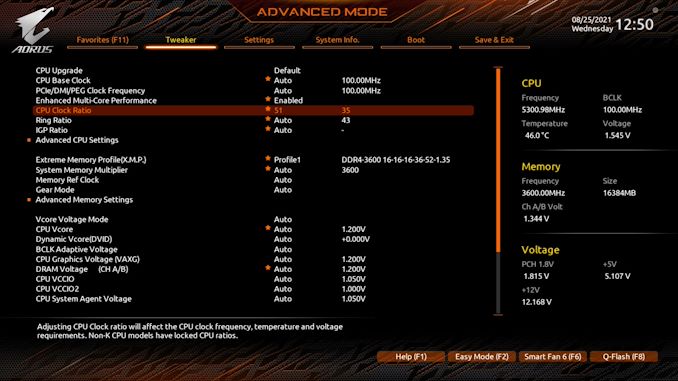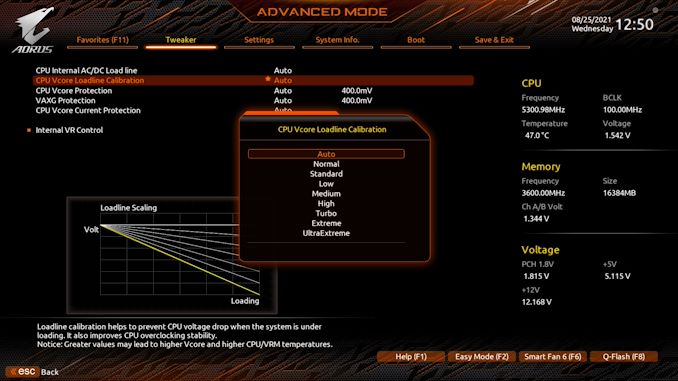Multi-chip Intel Core i9-11900K Overclocking Review: Four Boards, Cryo Cooling
by Gavin Bonshor on August 30, 2021 9:00 AM ESTThe GIGABYTE Z590 Aorus Master: A Quick Recap
Click here for the full review
The Z590 Aorus Master, in terms of the Aorus branded models, sits just below GIGABYTE's flagship Z590 Xtreme and Xtreme WaterForce models. The GIGABYTE Z590 Aorus Tachyon is specifically designed for extreme overclockers and maximizing overclocking performance with Rocket Lake, but this puts that model in a vaulted segment with a small handful of other Z590 models. The GIGABYTE Z590 Aorus Master includes three full-length PCIe slots, with the top two operating at PCIe 4.0 x16 and x8/x8, while the third slot is locked down to PCIe 3.0 x1. In the top right-hand corner of the board are four memory slots, with support for up to DDR4-5400 out of the box and a total combined capacity of 128 GB.

Storage options on the Z590 Master include three M.2 slots, including one PCIe 4.0 x4, two with support for both PCIe 3.0 x4 and SATA M.2 drives, and six SATA ports. The board also has many premium controllers, including a high-end Aquantia AQC107 10 GbE controller, an Intel AX210 Wi-Fi 6E CNVi, and a Realtek ALC1220-VB and ESS Sabre ESS9118 audio controller pairing. GIGABYTE includes a single USB 3.2 G2x2 Type-C port on the rear panel, with an impressive five USB 3.2 G2 Type-A ports and four USB 3.2 G1 Type-A ports also on the rear panel.
GIGABYTE Z590 Aorus Master Key Overclocking Variables
Some of the main features to consider on the GIGABYTE Z590 Aorus Master include:
- Large 19-phase power delivery operating at 9+1 (doubled design)
- 2 x 8-pin 12 V ATX CPU power inputs
- Large and dense passive VRM heatsinks
- Support for DDR4-5400 out of the box
Dissecting the large 19-phase power delivery, the Z590 Aorus Master uses an Intersil ISL69269 PWM controller operating at 9+1. The CPU section includes eighteen premium Intersil ISL99390 90 A power stages, which are doubled up with nine Intersil ISL6617A doublers. Looking at the SoC section, GIGABYTE is using a single Vishay SiC651 50 A power stage. It should be noted that the GIGABYTE has the largest power delivery of the four models we are testing in this article.

The 19-phase power delivery on the GIGABYTE Z590 Aorus Master (operating at 9+1)
Keeping the power delivery cool is a large and heavy two-part VRM heatsink that is interconnected by a single heat pipe. Both heatsinks are using copious amounts of aluminum fins designed to catch and direct passive airflow in the case, which is designed to improve the overall heat dissipation properties of the design.
GIGABYTE Z590 Aorus Master Firmware for Overclocking: Tweaker
The GIGABYTE firmware is consistent throughout its Aorus branded models with two modes for users to select between; the 'Easy' model for novice users and an 'Advanced' mode for the more experienced. GIGABYTE also has a basic yet functional-looking BIOS, consisting of a black background with white text and orange accents.
All of the overclocking options and settings are within the Tweaker menu, which can be found in the Advanced mode. The relevant options are listed in one large menu, with CPU frequency at the top, memory options in the middle, and voltage/power-related settings towards the bottom. Users looking to overclock the processor can simply enter or select the desired CPU Clock ratio from a dropdown menu and enter the required CPU VCore voltage. For users looking to overclock the memory, kits with built-in X.M.P 2.0 profiles can be enabled very simply, or users can overclock memory manually with options for frequency and various latency options.
Within the Advanced CPU Settings menu, users can disable AVX workloads and set custom CPU over-temperature protection variables, which in the case of the Master, it goes up to 115°C. There are also options to enable Intel's Turbo Boost technologies, disable C-States, and also manage different power-related functions of Intel's Rocket Lake processors. GIGABYTE has one of the best visuals for Loadline Calibration options, with multiple profiles to select between depending on how aggressive the CPU overclock may be.
Despite looking archaic compared to other vendors' firmware, the GIGABYTE Aorus UEFI BIOS is clean, easy to navigate, and use. There's a tonne of options for users to tweak both the CPU and memory with everything needed to push Rocket Lake on all types of cooling under one menu, aptly named Tweaker.
Getting a baseline on stability and maximum all-core frequencies using the GIGABYTE Z590 Aorus Master, we achieved the following:
| Achieved Stable Overclock on Each Core i9-11900K | ||
| Intel Core i9-11900K Sample | Achieved All-Core CPU Frequency |
Achieved CPU VCore Voltage (V) |
| Chip #1 - Batch V051F933 | 5.1 GHz | 1.330 V |
| Chip #2 - Batch V051F933 | 5.1 GHz | 1.350 V |
| Chip #3 - Batch V051F933 | 5.1 GHz | 1.350 V |
| Chip #4 - Batch X101J374 | 5.1 GHz | 1.370 V |
Using the GIGABYTE Z590 Aorus Master to overclock our CPUs, we did have issues getting any of the four Core i9-11900K's to 5.2 GHz without lots of performance reducing thermal throttling. This is despite increasing the temperature limits to 115°C and removing any throttling constraints. Anything over 1.420 V proved too hot for the board to handle. As we highlighted in our full review (link at the top of the page), the power delivery design seems to dump a lot of heat into the power plane instead of dissipating it, which is the likely culprit here.
In our VRM thermal testing during our full review of the board, we got the following results with the GIGABYTE Z590 Aorus Master with Chip #1 at 5.1 GHz with 1.450 V:
- VRM Sensor Temp: 78°C
- VRM Probe 1: 74°C
- VRM Probe 2: 77°C
- Ambient Temp: 24°C
Despite encompassing a large and premium design, the VRM thermal testing on the GIGABYTE Z590 Aorus Master did highlight what we see as a slight design flaw. Typically when keeping a power delivery cool, the heatsinks job is to dissipate as much thermal load from the components, but what we saw was essentially a heat dump into the board's power plane. The passively cooled design on the surface looks good, but we felt GIGABYTE could have done a better job on the design and implementation of the power delivery and heatsink. The extra heat dumped into the power plane around the CPU socket could be one of the reasons we only managed to achieve 5.1 GHz all-core on all of our chips during testing.












54 Comments
View All Comments
StevoLincolnite - Monday, August 30, 2021 - link
I just upgraded from my 10~ year old Core i7 3930K Sandy Bridge CPU, 6-cores, 12 threads. Overclocked to 4.6Ghz with 16Gb of Quad-Channel Ram...Haven't noticed much of a difference when upgrading to the Ryzen 9 5900X and 64GB of 3600Mhz Ram in the games I play. (Mostly just eSports titles)
But hoping this rig lasts 10~ years like my last one.
Sold my old system in parts and so far made about $1,000 AUD back, which is definitely a good return on investment... Enough to buy a Radeon RX 6700XT.
lemurbutton - Monday, August 30, 2021 - link
Buy Apple Silicon. Pretty soon, no amount of energy-wasting, environmentally unfriendly overclocks can match the speed of a 35w Apple Silicon thin and light Macbook Pro.TheinsanegamerN - Monday, August 30, 2021 - link
> suggesting an apple ARM device for the enviroment.My sides have entered hyperspace. How can one be so dense?
bigvlada - Monday, August 30, 2021 - link
That's what we were hearing about slow and melting Pentium 66 MHz and lightning fast and cool 90 MHz PowerMac.And no, "This time it will be different tm" won't work, because just like in 1984. and 1994. majority of people do not want a closed, barely repairable system. In those early days, you needed a bayonet sized screwdriver and soldering iron in order to expand memory on Apple machines.
joelypolly - Monday, August 30, 2021 - link
I mean... look at the smartphone market. It's a good indication that the market has changed and most people are just looking for a computing appliance.M O B - Monday, August 30, 2021 - link
Oh really. Do people normally want to swap out the GPU, RAM, disk, or WiFi/BT card in their android phone? Of course now. Phones, despite their computational power, are not computers. You fail at analogy.Every company except Apple at least makes it possible to swap out several components, granted that soldered RAM or PCIe SSDs are common in certain compact form factors.
vshade - Tuesday, August 31, 2021 - link
Smartphones are computers for most of the world, is the device they will communicate, make planning and game on.whatthe123 - Monday, August 30, 2021 - link
It's an indication of an entirely new premium market that relies on subscriptions to mask costs. Macs continue to dominate in profitability but they always trail in marketshare because the upfront costs are too high, and nobody can really even get that market except Apple since Apple is the only one that has successfully created and maintained a lifestyle culture around their products. In order for Apple's CPUs to sweep the rest of the market they'd need to sell their chips directly or macs would need to overtake everything else in volume, neither of which Apple seems interested in doing or is really able to do since they're capped by TSMC's output.Exotic - Tuesday, August 31, 2021 - link
On Desktop I agree as people generally want easy upgradability. Where Apple Sillicon will shine and be very impressive to a lot people will be in laptops. In 99.99% of laptops the CPU and GPU is soldered and is not user upgradeable and the same is to said for ultrabooks regarding RAM as that too is getting soldered onto the mainboard.Laptops also sell more than desktops these days.
Wrs - Tuesday, August 31, 2021 - link
Being closed and barely repairable is a side effect of tight integration, not necessarily with being Apple. It is true that Apple tends to be associated with pushing the curve on engineering/miniaturization and naturally this results in a higher price, but they don't have a monopoly on integration and neither does the PC side have a monopoly on expansion and the use of commodity parts.I remember Macs from the 90s, as well as Mac Minis in the 2010s that incorporated tool less entry to the RAM slots, and with just a few regular screws you can access the same on Intel iMacs. Hard drives were just more screws. That's leaving aside the Mac Pro lineup. Yet no modern smartphone lets you upgrade the RAM or internal storage because it takes a lot more effort to design user serviceability into such a tiny yet functional form factor.